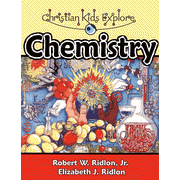
This morning my eight year old asked if he could make rock candy. I said, "sure, let's get out the chemistry book and see how it's made." If you know me, you know I cannot let such a terrific learning opportunity slip by without sneaking in every bit of knowledge possible. At first, only Drew was participating, but it wasn't long before Sophie wanted to join in on the fun.
The book we used was Christian Kids Explore Chemistry, by Robert and Elizabeth Ridlon.
I acquired this book second-hand a few years ago but like so many other good intentions, it sat on the shelf just waiting to be used. I searched the index for the section on saturation and voila! The lesson included directions on creating a saturated sugar solution.
To make the lesson even more valuable, I suggested that we use two jars, one with hot water, one with tap water.
We added the sugar a few teaspoons at a time and recorded on a small dry-erase board just how many teaspoons it took to reach saturation. You can tell when saturation has been reached when the sugar crystals no longer dissolve. Instead, they swirl around and settle on the bottom of the jar once stirring is ceased. I plan to have them do a little math as well to see how many teaspoons makes a tablespoon so they know how many tablespoons were used, how many tablespoons makes a cup of sugar and did we use a whole cup?
Several interesting observations were made by the children during the sugar adding. First, our wooden spoons began to float!
That was unexpected and we will be doing more research to figure out why that happened. ( If you know why, don't tell, that ruins the fun of learning why for ourselves.) Next, they realized that the water level was rising in the jars. I expected this but it was fun to let them discover it on their own. Finally, when we reached saturation, they wanted to add food coloring. When added to the solution, the drop of coloring floated on the surface! We had to stir to make it mix. When we dropped food coloring in plain tap water, it began to mix on its own. Another unexpected event that will be fun to research.
 | |
The hot water took much more sugar to become saturated. We can expand the lesson to explore why that happens.
We covered the jars with cheese cloth to allow the evaporation to begin but keep flies and other undesirables out of the jar. Soon we will suspend a string into each jar so the crystals will have something to cling to.






I won't give you the answer, but think of why it's easier to float in the ocean rather than the pool. Then think about floating in the Dead Sea.
ReplyDeleteI love the way you sneak learning in! Just like sneaking veggies into food...they get what's good for them without even realizing it! heh heh heh